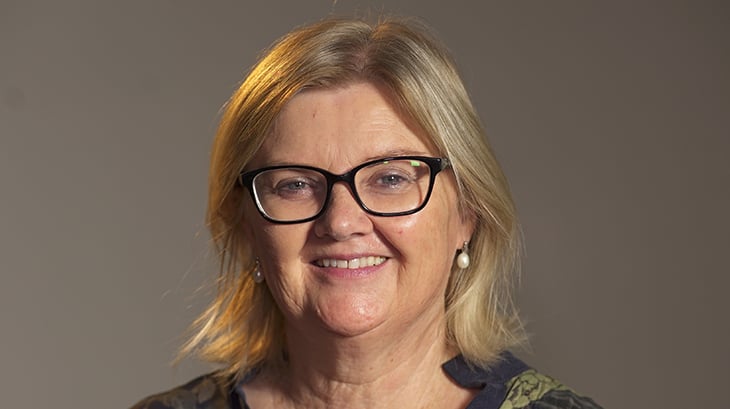Farmer of the Year says “Be confident and proactive”’

2023 Farmer of the Year Tess Herbert is a former Chair of the SSG.
2023 Farmer of the Year Tess Herbert’s leadership path in the beef industry began with a “tap on the shoulder” and an invitation to join the board of the Australian Lot Feeders Association (ALFA).
At the time she was a qualified teacher and mother of three running a 6000-head beef feedlot with her husband Andrew on their central New South Wales property, ‘Gundamain’, at Eugowra, which has been in the family for 150 years.
Tess subsequently spent nine years on the ALFA Board and was Chair for three of those.
“Sometimes being shoulder-tapped to take up a role is the best way, because it’s someone saying ‘I think you can do this’, and that gives you confidence,” Tess said.
“During my time with ALFA I went through the Australian Rural Leadership Program which built my confidence further, and then you get to the stage where you’re happy to put your hand up for a role because you’ve been doing it for a while and you know stuff.”
National award recognises work in an industry she loves
In 2018 Tess stepped down from ALFA to take up the role of Chair of the Australian Beef Sustainability Framework’s (ABSF) Sustainability Steering Group (SSG).
She spent three years as head of the SSG, focusing on data gaps and refining some of the key indicators, and in 2022, joined the Board of Meat & Livestock Australia (MLA) as a non-executive director.
“Inevitably you find someone to take over from you. Regular refreshment is good for a board, there are always people ready to step up and step in,” she said.
In June, Tess and Andrew were judged ABC Rural and the Kondinin Group’s 2023 Farmers of the Year.
The awards recognise the outstanding achievements of individuals and families making a significant contribution to Australian agriculture, but for Tess, it’s all part of working in the beef industry, which she loves.
As an interested beef producer and former SSG chair, she has watched the ABSF evolve over time to review industry processes, set goals and supply data to debunk claims of deforestation and excessive greenhouse gas emissions.
Framework conversations becoming ‘more nuanced’
There is still work to be done, Tess says, but the conversation has become more nuanced.
“I think the Framework has done the hard work of raising awareness and engaging the supply chains, and now it’s permeating through industry that we need to be prepared for stakeholders to keep asking questions,” Tess said.
“We need to respond by providing data. In the early days you couldn’t expect every data point to be measured – R&D had to catch up with what stakeholders were asking. But the more proactive we are now, the better prepared we will be.
“That means not just listening for what stakeholders say, but asking ourselves ‘What’s next?’ Not just responding, but proactively stating ‘We’ve got that covered’ or ‘Here’s what we’ve done’.”
And that doesn’t necessarily always mean a change in practice for the beef industry.
“The Framework isn’t an on-farm certification system, it’s a national reporting system. Most of the time producers will find that this demand for data is not a financial impost on their business.
“It’s more a matter of proving it, rather than just telling people you’re doing it.”
Natural capital next element to monitor and measure
As the Framework matures, different issues are emerging, such as the measurement of natural capital – the stock of natural resources which includes geology, soils, air, water and all living organisms.
“I think we’re in the early stages of getting our heads around natural capital, and the key will be to engage with supply chains who want to measure and monitor and who have sustainability standards,” Tess said.
“Producers need to be in the driver’s seat for what’s monitored and measured. Originally people were urged to set a baseline using carbon calculators for emissions or landscape, and that’s now extending to baselining more of your natural capital.
“That can mean vegetation and grasslands, tree cover and the biodiversity around plants and animals, but also important is an acknowledgement of the place of ruminant animals in a healthy landscape.
“More of that measurement would be really helpful for individual businesses, to illustrate that a lot of the work is already being done.”
Industry offers value to people and communities
One pillar of the Framework that Tess says would benefit from a deeper dive is people and community.
“The beef industry is a major contributor to economic prosperity, particularly in rural and regional areas, as well as to human health through the provision of nutritious red meat,” she said.
“Our own intensive feeding facility at Gundamain provides jobs for 20 people, but there’s also the grain, hay and cattle we buy, the neighbours we sell manure to or buy fodder from, and our interactions with the local area, which all contribute to the health of the community.”
Tess sees beef producers as ‘remarkably resilient and innovative’, and is not perturbed by the challenges to come.
“We can all provide the clarity to show consumers that they can trust us to produce food safely and treat the animals and the environment well,” she said.
““If you look further ahead, it’s establishing how we’re viewed as custodians and owners of the land. Are we looking after it and producing this bioavailable protein in the best possible manner?”
More information
Contact:
Resources: